#Pantanal Research Center
Explore tagged Tumblr posts
Text
BRAZIL - CPP and CBH Alto Araguaia promote a conversation wheel with farmers to share the experiences and techniques applied in the properties.

On World Wetlands Day 2024; The Revitalization Project promotes a conversation wheel with farmers to share the experiences and techniques applied in the properties.
Country : Brazil Organizer : Pantanal Research Center Partners : Comitê de Bacia Hidrográfica do Alto Araguaia
#Revitalization Project#world wetlands day#wetlands#Pantanal Research Center#brazil#2 february#Comitê de Bacia Hidrográfica do Alto Araguaia
0 notes
Text
Brazilian government scrambles as wildfires devastate world's largest rainforest — here's what's happening
This has been a difficult year for the Pantanal, a region that encompasses the world's largest tropical wetland area.
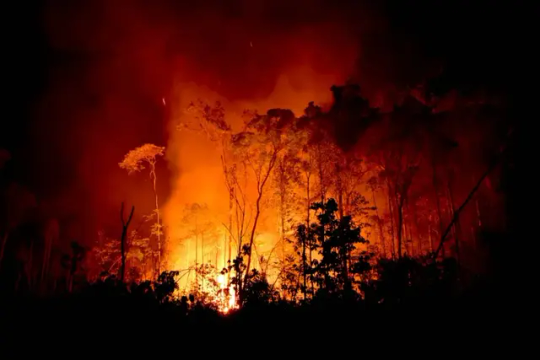
Brazil's worst drought on record is exacerbating a dire wildfire situation in the Amazon rainforest. The country's government enlisted the help of 3,000 firefighters to put out the blazes at one point, as the Guardian reported.
According to the country's National Center for Monitoring and Early Warning of Natural Disasters, Brazil is enduring its most "intense and widespread" drought on record, as Reuters reported. The drought has helped fuel an intense wildfire season in the Amazon this year.
The Guardian detailed that smoke from fires in Brazil lowered the air quality in São Paulo and Brasília, grounding flights and shutting down schools.
As Greenpeace shared, the Fire Monitoring Program of Brazil's National Institute for Space Research (INPE) reported more than 38,000 fire outbreaks in the Amazon during August, a 120% increase compared to the same period last year.
Continue reading.
#brazil#brazilian politics#politics#environmentalism#environmental justice#brazil forest fires 2024#image description in alt#mod nise da silveira
12 notes
·
View notes
Text
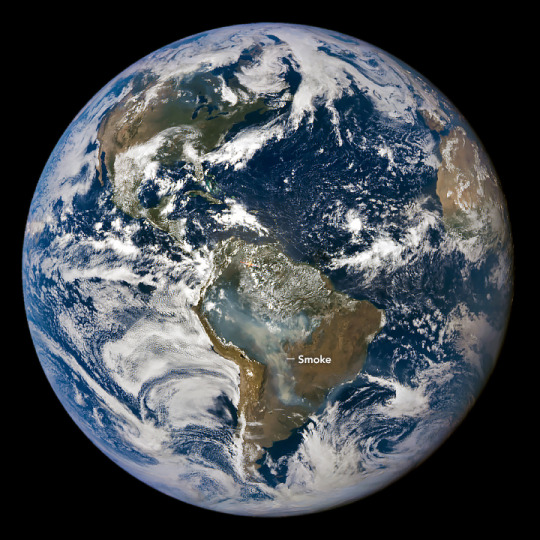
Smoke Fills South American Skies
Intense fires burning in several South American countries draped large swaths of smoke across the continent throughout August and early September 2024. In Brazil and Bolivia, fire activity reached levels not seen since 2010 as a prolonged drought parched landscapes in both countries.
From about 1 million miles (1.6 million kilometers) away from Earth, NASA’s EPIC (Earth Polychromatic Imaging Camera) imager on the DSCOVR (Deep Space Climate Observatory) satellite captured this view of smoke billowing from the blazes on September 3, 2024.
Smoke from fires in Brazil swept over the country’s capital city in mid-August and early September. For several days, São Paolo’s air was clouded with smog, and air quality was unhealthy for sensitive groups, according to AirNow. The smoke grounded flights and forced schools to close in the most populous city in Brazil, according to The Guardian.
The fire season in the southern Amazon, which generally ramps up in August and peaks in September and October, has been intense this year. According to the Copernicus Atmosphere Monitoring Service (CAMS), a component of the European Union’s space program, emissions from fires have been exceptionally high in Bolivia and the Brazilian states of Amazonas and Mato Grosso do Sul.
CAMS estimates near-real-time wildfire emissions using its Global Fire Assimilation System (GFAS), which aggregates observations made by the MODIS (Moderate Resolution Imaging Spectroradiometer) sensors on NASA’s Aqua and Terra satellites. Compared to the previous 21 years, these areas have registered their highest year-to-date total emissions, at 44, 22, and 13 million metric tons of carbon, respectively.
The Pantanal region—which straddles the Brazil-Bolivia border and is home to one of the world’s largest tropical wetlands—has been especially hard hit in 2024. Early and intense blazes spread over the wetlands in late May and continued into August. According to Brazil’s National Institute for Space Research (INPE), there were a record number of fire detections in the biome in June 2024, and fires have continued to burn at high levels since.

The false-color image above, acquired by the OLI (Operational Land Imager) on Landsat 8, shows fires near Ascensión de Guarayos, in the Bolivian state of Santa Cruz. The false-color image emphasizes the burn areas (brown) from several fires on September 3, 2024. Unburned vegetation is green. Near- and short-wave infrared bands help penetrate some of the smoke to reveal hot areas associated with active fires, which appear orange.
Through September 6, blazes tore through more than 10 million hectares of Bolivia, or roughly 9 percent of the country’s total area. Out of the 42 million metric tons of carbon emitted in Bolivia between May and August, 33 million metric tons came from fires in the state of Santa Cruz, according to Mark Parrington, CAMS senior scientist with the European Centre for Medium-Range Weather Forecasts (ECMWF).
Large parts of South America have seen significant rainfall deficits over the past three months. According to ECMWF, this has led to “exceptional drought” (the highest drought ranking) over much of the central and northern parts of the continent. Brazil’s Natural Disaster Monitoring and Alerts Center noted on September 5 that shifted rainfall patterns from El Niño, increased temperatures from climate change, and reduced humidity from deforestation have all contributed to the drought.
NASA Earth Observatory images by Michala Garrison, using data from DSCOVR EPIC and Landsat data from the U.S. Geological Survey. Story by Emily Cassidy.
2 notes
·
View notes
Text
Friday, September 13, 2024
Harris and Trump Bet on Their Own Sharply Contrasting Views of America (NYT) Donald J. Trump’s America is a grim place, a nation awash in marauding immigrants stealing American jobs and eating American cats and dogs, a country devastated economically, humiliated internationally and perched on the cliff’s edge of an apocalyptic World War III. Kamala Harris’s America is a weary but hopeful place, a nation fed up with the chaos of the Trump years and sick of all the drama and divisiveness, a country embarrassed by a crooked stuck-in-the-past former president facing prison time and eager for a new generation of leadership. These two visions of America on display during the first and possibly only presidential debate between Ms. Harris and Mr. Trump on Tuesday night encapsulated the gambles that each candidate is taking in this hotly contested campaign. Mr. Trump is betting on anger and Ms. Harris on exhaustion. Mr. Trump is trying to repackage and resell his “American carnage” theme eight years later, while Ms. Harris is appealing to those ready to leave that in the past. The question is who has a better read on the American psyche eight weeks before the final ballots are cast.
Cuba’s Broken Economy (El Espectador/Colombia) Cuba is on a downward spiral and appears to be headed for economic collapse. Cubans lack essential items such as food and medicine, especially milk and bread, while the prices of other products, such as gasoline and electricity, have increased by dizzying percentages of up to 500%. The island nation imports 80% of the food it consumes. In 1958, a year before the communist takeover, it was not only self-sufficient in beef, milk, tropical fruits, coffee, tobacco, fish and seafood, pork, chicken, vegetables and eggs, but it also exported surplus produce. Yet today, according to press reports, the magnitude of the crisis is such that Havana has contacted the UN World Food Program (WFP) for the first time in its history to request help. Since 1959 Cuba has systematically suffocated the private sector, renouncing innovation, competitiveness and excellence in the process. There have been consequences.
More than half of Brazil is racked by drought (Washington Post) In the north of Brazil, dried rivers have left communities accessible only by boat landlocked. In the central west, fires are razing what were once wetlands. And in the densely populated southeast, smoke from tens of thousands of blazes is choking cities. Brazil is in the grip of its worst drought on record, Brazil’s Center for Natural Disaster Monitoring and Alerts said this month, a drought that has parched at least 59 percent of Latin America’s largest country and dried out more than 1,400 cities. Along the Rio Madeira in Amazonas state, locals are trekking miles on the hot sands of the dried riverbed in search of water. In the Pantanal, the world’s largest tropical wetland, fires have scorched an estimated 20,000 square kilometers (7,720 square miles). The vast Cerrado region is in the grip of the worst drought in at least 700 years, according to researchers at the University of São Paulo. And the air in São Paulo state has grown so heavy with forest fire smoke that authorities have urged people to avoid physical activity outside.
England’s Health Service Is in Deep Trouble, Report Finds (NYT) England’s National Health Service, one of the country’s most revered institutions, is in “critical” condition, according to a government-commissioned report that cited long waits for treatment, crumbling hospitals, mental health patients in “vermin-infested cells” and far fewer M.R.I. scanners than in comparable countries. The hard-hitting review, published late on Wednesday, was commissioned by Britain’s new prime minister, Keir Starmer, after he won the general election. The dire state of the N.H.S. was a key reason many people voted for his Labour Party in July, according to polls. But the report underscores the scale of the challenge the government faces to revive a health care system that is in a spiral of decline after years of underinvestment and administrative meddling and is still suffering the aftershocks of the pandemic.
Lawmakers review plan to raise retirement age in fast-greying China (Reuters) China’s top legislative body this week assessed an official plan to delay the country’s retirement age, among the world’s lowest, taking a key step towards changing decades-old labour laws and easing economic pressures stemming from a shrinking workforce. The ruling Communist Party said in July that China would gradually raise the country’s retirement age. The retirement age is now 60 for men, about six years below that in most developed economies, while for women in white-collar work it is 55, and 50 for women who work in factories. Having people work for longer would abate some pressure on pension budgets with many Chinese provinces already reeling from large deficits. It would also delay pension payouts and require older workers to stay at their jobs longer, which may not be welcomed by all of them. Reform is urgent with life expectancy in China rising to 78 years as of 2021 from about 44 years in 1960, and projected to exceed 80 years by 2050. At the same time, the working population needed to support the elderly is shrinking.
Pope marvels at Singapore’s skyscrapers and asks that the lowest migrant workers not be forgotten (AP) Pope Francis on Thursday praised Singapore’s economic strength as a testament to human ingenuity but urged the city-state to look after the weakest, too, especially foreign workers, as he opened the final leg of his tour through some of Asia’s poorest countries in one of the world’s richest. In a common appeal from history’s first Latin American pope, Francis called especially for dignified pay and conditions for migrant workers, who have helped build Singapore into one of the world’s most advanced financial powerhouses. “These workers contribute a great deal to society and should be guaranteed a fair wage,” Francis said. Singapore has long touted as a success story its transformation from a colonial port lacking natural resources into a financial and trade power in just a few decades since independence from Malaysia in 1965. The former British colony enjoys one of the highest living standards in the world, and is known for its safety and low crime rate. But it is also one of the most expensive cities to live in and its competitive work environment makes for a stressful, overworked people.
Israeli Commandos Carried Out Raid on Secret Weapons Site in Syria (NYT) Israel carried out a commando raid in Syria on Sunday that obliterated a Hezbollah missile production facility near the Lebanese border, killing a number of people at the site, according to American and other Western officials. The operation included a daring raid by Israeli special forces, who rappelled down from helicopters and apparently seized materials from the missile facility, the officials said. Ground forces were used in the attack because of its complexity and to recover information from the secret weapons site, the officials said, adding that there were no Israeli casualties. The officials said the raid included airstrikes on the sprawling site, the Scientific Studies and Research Center, which is near Masyaf, in the country’s northwest. Syria’s state news agency, SANA, reported on Monday that 18 people were killed and dozens more injured.
New video, witnesses challenge Israel’s account of U.S. activist’s killing (Washington Post) Aysenur Eygi, a 26-year-old Turkish American, was fatally shot in the head on Friday in the village of Beita, near Nablus, following brief clashes after Friday prayers. The Israel Defense Forces said Tuesday it was “very likely” she had been hit “unintentionally” by one of its soldiers. “The incident took place during a violent riot,” the statement said, and the fire was aimed at “the key instigator.” But a Washington Post investigation has found that Eygi was shot more than a half-hour after the height of confrontations in Beita, and some 20 minutes after protesters had moved down the main road—more than 200 yards away from Israeli forces. Last month, another American citizen, Daniel Santiago, a 32-year-old teacher from New Jersey, was shot in the thigh by Israeli forces in the same olive grove where Eygi was killed. The IDF said Santiago was “accidentally injured” when soldiers “fired live rounds in the air” to disperse protesters.
2,000-Pound Bombs Likely Used in Mawasi Strike (NYT) Large craters and a bomb fragment from an Israeli airstrike on a camp for displaced people early Tuesday provide strong evidence that Israel used 2,000-pound bombs, according to three weapons experts. The United States has previously warned Israel that the powerful munitions can cause excessive civilian casualties in the densely populated Gaza Strip, and suspended exporting U.S.-made 2,000-pound bombs to Israel earlier this year. Israel said it had carried out “precise strikes” aimed at Hamas militants, but has so far declined to say what sort of bombs were used. At least 19 people were killed in the blasts and more than 60 others injured, Gazan authorities said, a toll that appeared likely to rise. Video filmed after the attack and verified by The New York Times showed two enormous blast craters measuring close to 50 feet wide.
South Africa’s traveling ‘health train’ (AP) Thethiwe Mahlangu woke early on a chilly morning and walked through her busy South African township, where minibuses hooted to pick up commuters and smoke from sidewalk breakfast stalls hung in the air. Her eyes had been troubling her. But instead of going to her nearby health clinic, Mahlangu was headed to the train station for an unusual form of care. A passenger train known as Phelophepa—or “good, clean, health” in the Sesotho language—had been transformed into a mobile health facility. It circulates throughout South Africa for much of the year, providing medical attention to the sick, young and old who often struggle to receive the care they need at crowded local clinics. For the past 30 years—ever since South Africa’s break with the former racist system of apartheid—the train has carried doctors, nurses and optometrists on an annual journey that touches even the most rural villages, delivering primary healthcare to about 375,000 people a year.
Cholera Deaths Soar Worldwide Despite Being Easily Preventable (NYT) The cholera outbreaks spreading across the globe are becoming more deadly. Deaths from the diarrheal disease soared last year, far outpacing the increase in cases, according to a new analysis by the World Health Organization. Cholera is easy to prevent and costs just pennies to treat, but huge outbreaks have swamped even well-prepared health systems in countries that had not confronted the disease in years. The number of cholera deaths reported globally last year increased by 71 percent from deaths in 2022, while the number of reported cases rose 13 percent. Much of the increase was driven by conflict and climate change, the W.H.O. report said. “For death rates to be rising so much faster even than cases are increasing, this is totally unacceptable,” said Philippe Barboza, who leads the cholera team in the health emergencies program of the W.H.O. “It reflects the world’s lack of interest in a disease that has plagued humans for thousands of years, afflicting the poorest people who cannot find clean water to drink,” he said. “How can we accept that in 2024 that people are dying because they don’t have access to a simple bag of oral rehydration salts that cost 50 cents?”
“A hug? Why not!” (Worldcrunch) A video of King Charles sharing a hug with the New Zealand women's rugby union team at Buckingham palace has gone viral on social media. The British sovereign was hosting the Black Ferns—set to play against England's Red Roses on Saturday—at the palace when winger Ayesha Leti-I'iga asked him to share a hug with the team. “Why not?,” he answered before getting a group hug.
0 notes
Text
BRASILIA, Brazil (AP) — The buildings in Brazil’s modernist capital, Brasilia, have been enveloped in smoky air the past two days. The central part of the country is just the latest region affected by smoke from fires in the Amazon rainforest, Cerrado savannah, the Pantanal wetland and the state of Sao Paulo.
The smog crisis prompted President Luiz Inácio Lula da Silva to visit Brazil’s fire monitoring center Sunday afternoon. “No fires caused by lightning were detected. This means that people are setting fires in the Amazon, the Pantanal, and especially in the state of Sao Paulo,” he said. His government pledged to step up firefighting and investigations to identify the culprits.
Fire alerts so far this month total almost 3,500 in southeastern Sao Paulo state — the most registered in any month since data collection began in 1998. Over half those fires occurred on Aug. 23, raising the suspicion of a coordinated attack. The smog caused 48 cities to declare a red alert. The good news was that a cold front Monday brought declining temperatures and rain, extinguishing all fires, the state government said.
In Brasilia, the air quality index reached a very unhealthy level on Sunday night, according to Brasilia’s environment institute. This is the first time the state agency has recorded a smog alert since its creation in 2007. Public events were canceled, and the airport of the nearby city of Goiania was closed for a few hours.
Amazon cities such as Manaus, Porto Velho and Rio Branco have been choking on smoke for several weeks but have received less official and media attention. This is partly because it´s an annual occurrence.
“It took the smoke and soot from the Amazon and the Cerrado invading the halls of the presidential palace for the federal government to wake up,” Altino Machado, a journalist based in Rio Branco who has been writing about the environment for four decades, told The Associated Press.
In the state of Sao Paulo, two employees working at an industrial plant died Friday while trying to fight back a fire. Additionally, a total of 59,000 hectares (146,000 acres) of sugar cane plantations were destroyed, according to a producers association. In the Amazon, a federal brigade firefighter also died Monday while working in the Capoto Jarina Indigenous Territory.
The smog that covered Sao Paulo state and Brasilia partially originated in the Amazon, Pantanal and Cerrado, according to Karla Longo, a researcher who monitors smoke at the National Institute for Space Research, a federal agency. Longo said changes in climatic conditions are the main reason smoke reached these regions.
During the driest months of August and September, when wildfires and deforestation peak, the smog typically spreads up to 5 million square kilometers (1.9 million square miles), traveling from east to west and then south after hitting the Andean Cordillera. Earlier this month, it reached Rio Grande do Sul, Brazil’s southernmost state.
However, the arrival of a cold front displaced the smog toward Sao Paulo state, which was already experiencing a record number of fires, and then spread to Brasilia’s region, Longo said.
The researcher also said the number of Brazil’s wildfires this year is not outside the norm. However, she noted that burned areas are larger than average. From January through July, an area the size of Italy had burned — 64% larger than the same period last year, according to official data. Fires are traditionally used as the last procedure for deforestation and for managing pasture.
Almost half of Brazil’s carbon emissions come from deforestation. The country is the world’s fifth-largest emitter of greenhouse gases, with almost 3% of global emissions, according to Climate Watch, an online platform managed by World Resources Institute.
0 notes
Text
ALLATRA: A Wake-Up Call to Save Earth
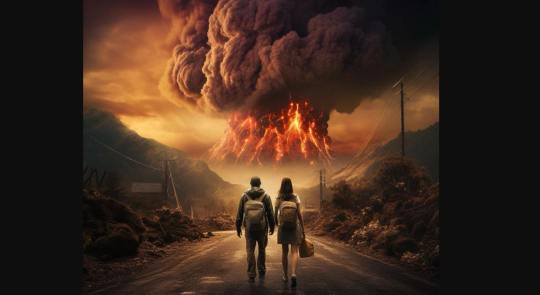
Planet Earth, our shared home, is groaning under the blows of the climate crisis. The Pantanal, the world's largest wetland, is burning. Vast swathes of land are covered by a blanket of white ash. Hospitals and medical centers in Corumbá are overflowing with patients suffering from respiratory illnesses, with children under five and people over 60 suffering the most from the smoke.
According to the Institute of Space Research, the number of fires has increased by 1,500% from January to July compared to the same period last year.
The Pantanal ecosystem is unique. Alongside the vital role wetlands play for biodiversity, they also have global significance for the climate.
This is a reservoir for hydrogen; 20-30% of the Earth's carbon is stored here.
“Forest fires are a signal: nature is raising the flag. We've had fires before, but now thousands and thousands of hectares are burning every year.
We are losing the battle,” says Pierre Girard from the Federal University of Mato Grosso.
We are standing on the edge of an abyss, and only global unity can prevent catastrophe.
ALLATRA - The Voice of Hope:
The ALLATRA International Public Movement is doing everything possible to save the planet from climate collapse.
ALLATRA volunteers are conducting large-scale campaigns to inform the public about the reality of climate threats.
Global Dialogue and Concrete Actions:
Last month, the President of ALLATRA met with Pope Francis to discuss global climate report.
She presented him with the climate report 'On The Progression Of Climatic Disasters On Earth And Their Catastrophic Consequences'.
This is a testament to ALLATRA's openness to dialogue with world leaders, seeking to draw attention to the critical nature of the situation.
ALLATRA President Discussed Climate Change with Pope Francis (dcnewsnow.com)
We are losing the battle:
The fires in the Pantanal are another sign that nature is starting to fight back. Thousands of hectares of forest are burning every year. We must understand that the time to act is now.
The salvation of humanity is in our hands:
ALLATRA believes that only the unification of people, scientists, and a scientific and technological breakthrough can help us prevent a global catastrophe.
Call to Action:
Let's work together to actively spread information about the real climate threats. Let's create a public demand for the unification of scientists and for real actions to prevent disasters.
This is extremely important information, please share it, comment, like, repost, and of course, applaud!
SUBSCRIBE TO MY CHANNEL
#ALLATRA #climate crisis #saveearth #thefutureisinourhands
0 notes
Text
The Ten Most Significant Science Stories of 2020
https://sciencespies.com/nature/the-ten-most-significant-science-stories-of-2020/
The Ten Most Significant Science Stories of 2020

Covid-19 dominated science coverage in 2020, and rightly so. The world grappled with how to combat the SARS-CoV-2 virus, learning about how it spread (whether it was on surfaces, via droplets or being airborne) and how it affected the human body (from immunity to symptoms like loss of smell.) But scientific endeavors in other fields, whether affected directly by the pandemic or indirectly by public health measures, didn’t come to a complete halt because of SARS-CoV-2. In incredible advances, researchers used three new tools for making discoveries about the sun, discovered that dinosaurs got cancer and published a study on a discovery in a Mexican cave that changes the timeline of humans’ arrival to the Americas. But none of those moments made this list of the biggest science stories of the year. It’s a subjective round-up, of course, but one compiled by our editors after much thought and debate. Presenting the key innovations, studies and discoveries that made 2020 an unforgettable year in science:
Companies Develop Covid-19 Vaccines in Record Time

A vile of the Pfizer-BioNTech vaccine against COVID-19 that was delivered to Arrowhead Regional Medical Center in Colton, California
(Irfan Khan / Los Angeles Times via Getty Images)
Since the first case of Covid-19 was reported in China late last year, more than 802 million cases and more than 1.7 million deaths have been confirmed around the world. In the United States, more than 19 million patients have tested positive for the disease and more than 338,000 of them have died. While the disease continues to spread and cause death, help is in sight thanks to the record-setting effort to develop vaccines. In less than a year, Moderna and Pfizer, in cooperation with BioNTech, created the first messenger RNA (mRNA) vaccines ever to protect against Covid-19. An mRNA vaccine contains a synthetic version of RNA that tricks the immune system into thinking a virus is present so that it will make antibodies designed to fight the virus. This is different from a traditional vaccine, which is made of small amounts of an existing virus. The previous record for vaccine development was for mumps, which took four years in the 1960s, but Moderna started working on a vaccine in January and Pfizer and BioNTech began working together in March. By July, both companies began late stage trials, each with roughly 30,000 participants. In November, the companies declared their vaccines were more than 90 percent effective. By mid-December, the FDA approved both vaccines for use in the United States. National Institute of Allergy and Infectious Diseases director Anthony Fauci hailed the accomplishments as a “triumph.” Now comes the complicated, months-long process of distributing the vaccines to the public.
NASA Snags Its First Asteroid Sample

Artist’s conception of NASA’s OSIRIS-REx spacecraft collecting a sample from the asteroid Bennu
(NASA/Goddard/University of Arizona)
In October, the NASA spacecraft OSIRIS-Rex reached out and grabbed rocks from a 4.5-billion-year-old asteroid named Bennu. The mission, which took place more than 200 million miles away from Earth, marked the first time the space agency reached out and touched an asteroid. The craft was supposed to land on the mass, but the surface proved too rocky, so the team behind the effort pivoted to using a robotic arm to snatch a sample. The smashing success almost worked too well; the collection module vacuumed up so much rock that a vital flap couldn’t close. Scientists abandoned their plans to measure the sample and took days to implement an effort to successfully store the rocks. The sample should arrive on Earth three years from now. Experts think it may contain water and prebiotic material, the building block of life. Such evidence might offer clues about how life on Earth started.
Habitats Burn During One of the Hottest Years on Record

Flames surround Lake Berryessa during the LNU Lightning Complex fire in Napa, California on August 19, 2020.
( Josh Edelson/AFP via Getty Images)
As of the writing of this list, 2020 is in competition with 2016 to be the hottest year ever recorded. This possible peak continues a dangerous trend, with the ten hottest years ever documented all occurring since 2005. Perhaps no illustration of the effects of climate change this year was more dramatic than the preponderance of massive wildfires. Millions of acres in Australia, which was set up for disaster as 2019 marked its hottest and driest year on record, burned from last October into January 2020. Thousands of Australians fled their homes, and many animals died or scurried from their threatened habitats. In Brazil, fires ravaged the Pantanal, the world’s largest tropical wetland, from July through October. Roughly a quarter of the ecosystem , which is larger in area than Greece, burned. Residents and animals abandoned their homes for safety, unsure of what would remain when they returned. In the United States, California recorded its worst fire season ever, with more than 3 million acres destroyed. Massive fires have dominated the state recently, with seven of the most destructive burns taking place in the last five years. Hot, dry summers, due in part to climate change, have set the region up for longer, more volatile fire seasons.
Scientists Discover Signs of Possible Life on Venus, or Maybe Not

Venus is a world of intense heat, crushing atmospheric pressure and clouds of corrosive acid.
(NASA/JPL-Caltech)
In September, astronomers published a pair of papers saying they detected a gas called phosphine on Venus. They said the discovery, which was made using telescopes in Hawaii and Chile, suggested a living source for the gas because other conditions on the planet couldn’t lead to phosphine formation. News outlets from The New York Times to National Geographic picked up the story, while reporting that some experts were skeptical of the finding. In October, three independent follow-up studies failed to find the gas on Venus. One of the studies used new data, and the other two used the initial team’s original data. In November, the original team revised their figures and said that phosphine levels were seven times lower than their initial estimate. As the debate about the presence of the gas continues, the story is important not just because of the correction, but because of what it shows: Science is a process in which findings are presented and then opened up to scrutiny and revision.
Microplastics Invade the Furthest Reaches of the Globe
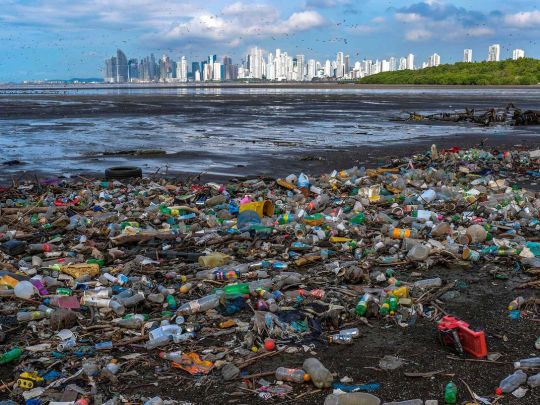
Plastic debris covers the beach of the Costa del Este neighborhood in Panama City.
(Luis Acosta/AFP via Getty Images)
News that microplastics have spread into many of the earth’s habitats is nothing new, but this year, scientists published several studies showing that the amount is much greater than previously thought and the reach is much further than previously documented. In April, researchers documented microplastics in Antarctic sea ice for the first time. In June, a study published in Science estimated that 1000 tons of airborne plastic debris rains down on national parks and remote stretches of wilderness in the United States. The country’s estimated contribution of plastic waste to the oceans was shown to be double what was previously thought. And in October, scientists published a study estimating that 15.8 million tons of microplastic are embedded in the Earth’s seafloor—or a lot more than is floating at the ocean’s surface. Not only the planet’s lowest points have been trashed; scientists published a study in November that found microplastics in every sample collected from the slopes of Mount Everest, with one such sample collected at 27,690 feet above sea level. Plastic debris has infiltrated Earth’s water, air and the living tissues of so many creatures, including humans. What scientists don’t know yet, is all of the ways the pollution affects us.
Three Different Early Humans May Have Lived Together in South Africa
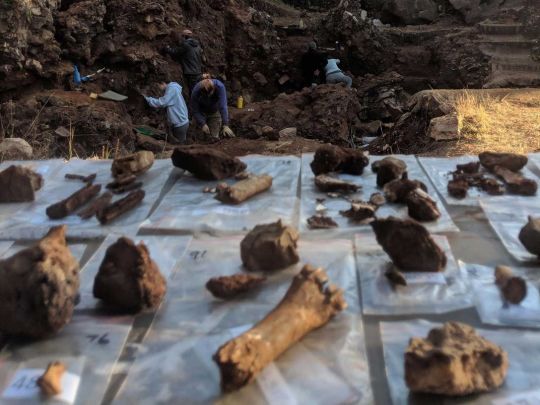
The Drimolen excavations and excavated fossils
(Andy Herries)
Despite being widely discredited in modern archaeology, orthogenesis—the theory that species evolve in neat succession, with new species replacing extinct species without much overlap—still looms large in the public understanding of human evolution. Researchers now say that evolution may have looked more like a scene first described in April this year, where three different species of possible human ancestors lived together in the same ancient cave in South Africa’s Cradle of Humanity. Tucked away in a roofless, amphitheater-like dwelling known as the Drimolen Paleocave System, skull fragments from Australopithecus africanus, Paranthropus robustus and Homo erectus were found to date back to 1.95 million years ago. This time period would mark the end of Australopithecus’s reign and the early beginnings of Paranthropus’s short-lived existence. Remarkably, the find could push back H. erectus’s origins by about 100,000 years; a cranium fragment scientists discovered might be the earliest fossil evidence of the species. Collapsed layers of fossil-packed sediment make precise dating tricky, but this study provides new evidence of multi-species hominin coexistence in a new geographic location, suggesting our ancestors were much more diverse than previously thought.
New AI Tool Cracks a Decades-Old Problem in Biology
youtube
Proteins are tiny molecular structures that make life on Earth go ’round. All proteins start out as a chain of chemical compounds called amino acids. Those chains then fold, twist and turn over and over again into perplexing tangles that eventually develop a three-dimensional shape. A protein’s shape defines what it can and can’t do—enter and alter certain cells, for example. When scientists can determine those 3-D shapes, the knowledge helps them understand how viruses spread, crack genetic codes and breakdown cellular infrastructure. Researchers have been searching for ways to crack the code of protein structures for 50 years. Scientists using existing technology require years of trial and error efforts to figure out a protein’s shape. This year, Google’s artificial intelligence company DeepMind debuted a deep-learning tool called AlphaFold that can determine a protein’s structure in a matter of days. The potential applications and breakthroughs this technology offers are numerous, including quicker and more advanced drug discovery. As one researcher described the find to Nature magazine, “It’s a breakthrough of the first order, certainly one of the most significant scientific results of my lifetime.”
The United States Is On Track to Eliminate Cervical Cancer

A pediatrician gives an HPV vaccination to a 13-year-old girl in Miami, Florida.
( Joe Raedle/Getty Images)
In a year plagued by a different kind of virus, good news is on the horizon regarding a form of cervical cancer associated with the human papillomavirus (HPV). Even without increased vaccination or screening, the United States is on pace to eliminate cervical cancer within the next 20 to 30 years, according to report released this year. When pap smears were widely introduced and regularly implemented at a global scale nearly a half-century ago, cervical cancer deaths began to drop. A vaccine introduced in 2006 prevented HPV infections that lead to cervical cancer. If medical professionals ramp up current vaccination and screening efforts, cervical cancer could be eliminated even sooner than expected, according to statistical models used in the study.
The United States Watched Washington Scientists Battle Invasive ‘Murder Hornets’
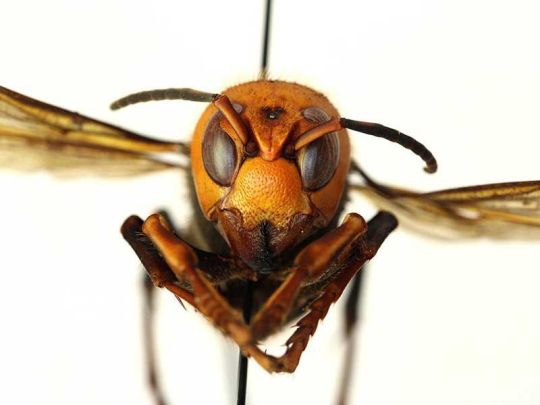
The Asian giant hornet, the world’s largest hornet, was sighted in North America for the first time.
(Washington State Dept. of Agriculture)
With a nickname like “murder hornets,” Asian giant hornets were hard to ignore, even though researchers spotted only a few at first. Asian giant hornets (Vespa mandarinia) decimate honey bee populations fairly efficiently (hence their nickname) and their sting is far mightier than any common bee found in North America. But after the New York Times published an article about scientists’ efforts to get ahead of the species before they settled for good in Washington state and British Columbia, the internet was abuzz with interest. Though four hornets had been spotted since fall 2019, it wasn’t until early October that the first live hornet was captured. By mid-October, entomologists found, isolated and incapacitated a nest that contained more than 500 “murder hornets,” including 200 queens. Though scientists may have arrived there in the nick of time, it’s impossible to know whether some of those queens mated and set off to start their own colonies, so a team is still on the lookout for the stinging beasts. All in all, the internet hysteria was exaggerated—and not exactly harmless either. Search engine inquiries about pesticides jumped, and common, oft-overlooked pollinators prompted panicked calls to local environmental agencies. One good thing to come out of the story? Folks learned a bit about the importance of controlling invasive species.
In 50 Years, Humans Have Decimated Two-Thirds of the World’s Wildlife

A leatherback sea turtle hatchling, an endangered species, crawls to the ocean.
(Mark Conlin/VW PICS/UIG via Getty Image)
Since 1970, 4,392 mammals, amphibians, birds, fish and reptile species’ population sizes declined by 68 percent, according to a World Wildlife Fund report released this year. Animals living in Latin America and the Caribbean took the biggest hit; their population sizes decreased by 94 percent. Habitat destruction is cited as the leading cause of these massive losses. The United Nations’ Global Biodiversity Outlook report produced similarly grim results. The document took inventory of 196 countries committed to recovering biodiversity as determined by the 2010 Aichi Biodiversity Targets. As dictated by the Aichi agreement’s ten-year plan, countries were to achieve certain recovery milestones like preventing the spread of invasive species and conserving protected areas. Most of the goals were not achieved or only partially met. Furthermore, the reports warned that pandemics, like the one the world is currently facing, could become more common if humans’ “broken” relationship with the natural world is not mended. In a statement, U.N. Convention of Biological Diversity executive secretary Elizabeth Maruma Mrema said, “the more humanity exploits nature in unsustainable ways and undermines its contributions to people, the more we undermine our own wellbeing, security and prosperity.”
#Nature
25 notes
·
View notes
Text
Pantanal suffers the biggest devastation in its history as volunteers struggle to save animals

Volunteers and veterinarians take care of the jaguar rescued by the Falcão family during the fires in the Pantanal in Mato Grosso. JOÃO FALCÃO
The fires that have ravaged the Pantanal for two months are the biggest in history. Data from the National Center for the Prevention and Fighting of Forest Fires (Prevfogo) show that 15% of the Pantanal was consumed, an area equivalent to 2.2 million hectares, or the territory of Israel.
Until mid-September, the satellites that monitor the region for the National Institute for Space Research, Inpe, have already detected 12,703 active fires, representing dozens of uncontrolled fires.
More than numbers, however, the fires in the world's largest floodplain are a devastating tragedy for one of the country's most preserved biomes hitherto sheltered from extinct animals in other regions, such as the jaguar. Important fauna refuges have been decimated in the wide zone that is in the extreme west of Brazil, between Mato Grosso and Mato Grosso do Sul and the borders of Bolivia, Argentina and Paraguay. Among these areas are the Encontro das Águas State Park, known for being home to the largest concentration of jaguars on the planet, and the Perigara Indigenous Land, in Mato Grosso, and part of the Serra do Amolar, in Mato Grosso do Sul.
#pantanal in flames#brazil is burning#brazil#brasil#we need to talk about brazil#environment#animals rights#fires#pantanal
15 notes
·
View notes
Photo
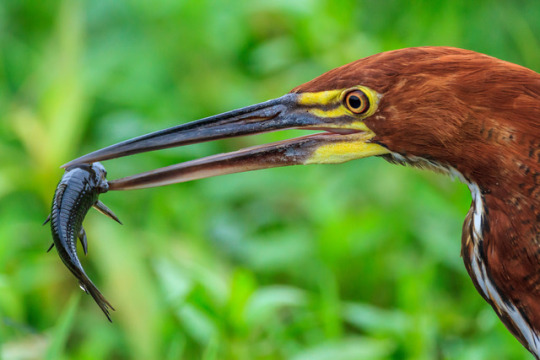

Rufescent Tiger Heron (Tigrisoma lineatum) eating a fish, Jaguar Research Center, The Pantanal, Brazil
photographs by Dagget2 | Flickr CC
1K notes
·
View notes
Text
More than half of Brazil is racked by drought. Blame deforestation.

In the north of Brazil, dried rivers have left communities accessible only by boat landlocked. In the central west, fires are razing what were once wetlands. And in the densely populated southeast, smoke from tens of thousands of blazes is choking cities.
Brazil is in the grip of its worst drought on record, Brazil’s Center for Natural Disaster Monitoring and Alerts said this month, a drought that has parched at least 59 percent of Latin America’s largest country and dried out more than 1,400 cities.
Even in a country that has grown increasingly inured to the damage wrought by drought — which in recent years has dried out swaths of the Amazon forest, killed scores of river dolphins and caused some territory to be reclassified as arid — recent scenes of privation and struggle have been startling.
Along the Rio Madeira in Amazonas state, locals are trekking miles on the hot sands of the dried riverbed in search of water. In the Pantanal, the world’s largest tropical wetland, fires have scorched an estimated 20,000 square kilometers (7,720 square miles). The vast Cerrado region is in the grip of the worst drought in at least 700 years, according to researchers at the University of São Paulo. And the air in São Paulo state has grown so heavy with forest fire smoke that authorities have urged people to avoid physical activity outside.
Much of the crisis, scientists say, can be explained by climate change, which is driving temperatures higher and making rainfall more unpredictable. But it’s been exacerbated by the deforestation of the Amazon, which has the potential to disrupt rainfall patterns across much of South America.
Continue reading.
#brazil#brazilian politics#politics#environmentalism#environmental justice#image description in alt#mod nise da silveira#the last time it rained where i live was in april 🫠
13 notes
·
View notes
Text
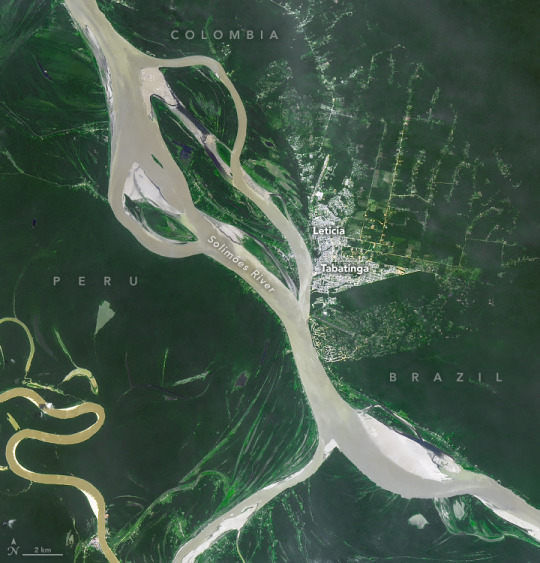

Intense, Widespread Drought Grips South America
Rivers in the Amazon basin fell to record-low levels in October 2024 as drought gripped vast areas of South America. Months of diminished rains have amplified fires, parched crops, disrupted transportation networks, and interrupted hydroelectric power generation in parts of Brazil, Bolivia, Colombia, Ecuador, Peru, and Venezuela.
This pair of Landsat images illustrates the shrinking Solimões River near Tabatinga, a Brazilian city in western Amazonas near the border with Peru and Colombia. The lower image above was captured by the Operational Land Imager-2 (OLI-2) on September 21, 2024. The other image (top) shows the same area on September 21, 2021, when water levels were closer to normal.
On October 4, 2024, river gauge data from the Brazilian Geologic Service indicated that the Solimões had fallen to 254 centimeters below the gauge’s zero mark, a record low. Rivers that day also reached record lows near the cities of Porto Vehlo, Jirau-Justante, Fonte Boa, Itapéua, Manacapuru, Rio Acre, Beruri, and Humaitá. Water height data collected by satellite altimeters and processed by a team of NASA scientists reported unusually low water levels at several Brazilian lakes and reservoirs as well, including Lake Tefe, Lake Mamia, Lake Mamori, Lake Ariau, Lake Faro, and Lake Erepecu.
The drought is related in part to the lingering impact of El Niño, a climate pattern that was present for the latter half of 2023 and first half of 2024. The phenomenon—associated with an unusually warm layer of water in the equatorial Pacific—typically shifts rainfall patterns in a way that reduces rain in the Amazon, especially during the dry season months of July, August, and September, according to Prakrut Kansara, a hydrologist at Johns Hopkins University.

Brazil’s National Center for Monitoring and Early Warning of Natural Disasters (CEMADEN) noted that an area of unusual warmth in the North Atlantic may have also affected rainfall patterns and contributed to the drought. “The magnitude of the current drought is roughly double what the region saw in 2015-2016, the last time a strong El Niño occurred,” Kansara said.
Kansara is part of a USAID-NASA SERVIR project that provides retrospective analyses of the region’s hydrometeorology and produces fire risk forecasts for CEMADEN. The team’s analysis indicated that western Amazonas in Brazil, northern Peru, eastern Colombia, and southern Venezuela received more than 160 millimeters (6 inches)—less rain in July, August, and September than usual. During that period, streamflow dropped more than fourfold, according to Kansara.
Since early 2024, the team’s seasonal forecasts warned that the Amazon basin would face extreme fire conditions during the dry season. Indeed, expansive plumes of smoke enveloped the southern Amazon between July and October, particularly in the Pantanal region that spans parts of southern Brazil, Paraguay, and Bolivia. Data from Brazil’s National Institute for Space Research and the Copernicus Atmosphere Monitoring Service shows that the Pantanal region—and especially Bolivia—has experienced one of its worst fire seasons in decades. NASA’s EPIC (Earth Polychromatic Imaging Camera) imager on the DSCOVR (Deep Space Climate Observatory) satellite captured the image of smoke billowing from the fires in the Pantanal shown below on September 3, 2024.
Lack of rainfall, low soil moisture, and a drawdown of groundwater helped amplify the fires and caused them to spread faster and farther. The map above shows shallow groundwater storage for the week of October 7, 2024, as measured by the Gravity Recovery and Climate Experiment Follow-On (GRACE-FO) satellites. The colors depict the wetness percentile, or how the amount of shallow groundwater compares to long-term records (1948-2010). Blue areas have more water than usual, and orange and red areas have less.

“Low rainfall in the Pantanal during last year's wet season—roughly November through February—predisposed this region to a greater risk of fire,” said Doug Morton, an Earth system scientist based at NASA’s Goddard Space Flight Center. “On the GRACE map, you also see a strong drought signal to the north in Peru, Colombia, Venezuela, and western Brazil—the source of many of the rivers that are now running dry across the central Amazon.”
Drought impacts have been far-reaching. News reports indicate that the drought has strained power supplies in Brazil and Ecuador as hydroelectric power stations generate less electricity. Snarled transportation networks and impassable rivers have left some communities struggling to get supplies, according to Reuters.
The drought is also affecting scientific research. “We work with colleagues in Peru, Brazil, and Ecuador on an early warning forecast system for malaria who haven’t been able to access some research sites due to low water levels,” said Kansara.
CEMADEN called the current drought the most intense and widespread Brazil has experienced. A drought update published on October 3 indicated that the number of Brazilian municipalities facing extreme drought was poised to increase from 216 in September to 293 by the end of October.
NASA Earth Observatory images by Michala Garrison, using Landsat data from the U.S. Geological Survey, GRACE-FO data (NASA-GFZ) available from the National Drought Mitigation Center, and DSCOVR EPIC from NASA. The fire risk forecasts and hydrometeorological analyses from the USAID-NASA SERVIR project use data from NASA’s GEOS S2S forecast model, the Land Information System (LIS), and Integrated Multi-satellite Retrievals for GPM (IMERG). Story by Adam Voiland.
0 notes
Photo
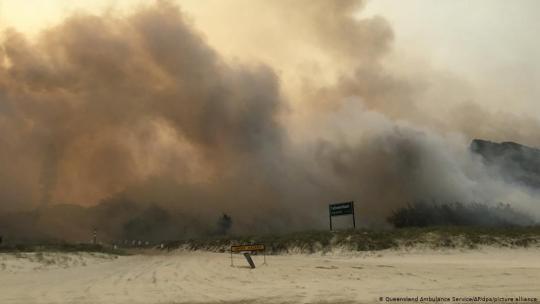
New Post has been published on https://freenews.today/2020/12/08/wildfires-fraser-island-is-just-one-unesco-heritage-site-threatened-by-climate-change-dw-08-12-2020/
Wildfires: Fraser Island is just one UNESCO heritage site threatened by climate change | DW | 08.12.2020

On the small sandy paradise of Fraser Island, or K’gari, off the east coast of Australia, the indigenous Butchulla people have maintained the delicate ecosystem of the rainforest on the sand dunes with controlled fires — known as “cool burns” — for generations.
But there was nothing controlled about the enormous bushfire that began spreading across the island more than seven weeks ago. Believed to have been started by a tourist campfire in October, the blaze reached its peak this weekend when it tore through the island’s rainforest and forced many residents to evacuate their homes.
So far, the houses of the island’s 200 residents have been spared the flames — but the same cannot be said of the natural landscape on the World Heritage-listed island. Over half the rainforest — 8,500 square kilometers (3,282 square miles) according to dpa news agency — has been destroyed by the fires.
The devastation comes at the beginning of Australia’s wildfire period. Last year, in what became known as “Black Summer,” some of the most deadly and widespread fires the country has ever witnessed killed 1.25 billion animals according to conservation organization, World Wildlife Fund (WWF), burned houses to the ground and destroyed hundreds of thousands of square kilometers of bush.

On Fraser Island, the rainforest grows on sand dunes
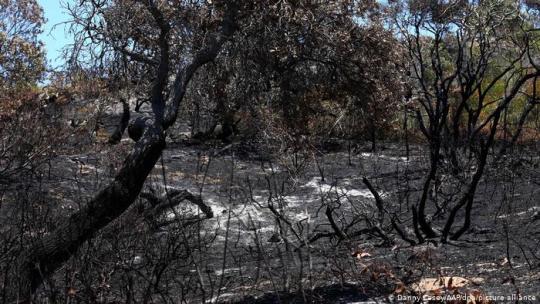
The fire has left much of the rainforest destroyed
“Fire seasons are lengthening worldwide, and we know that in Australia our fire seasons are starting earlier and finishing later, with more dangerous fire days occurring earlier in the season than they have previously,” Richard Thornton, CEO of the Melboure-based non-profit Bushfire and Natural Hazards Cooperative Research Center, told DW by email.
“Climate change plays a role in this — Australia is now one degree Celsius warmer compared to the long-term average, which means that the variability of ‘normal’ events sits on top of that,” he added.
UN report blames climate change
The destruction of the island’s natural heritage comes as a new UN-backed report names climate change as the top threat to natural World Heritage sites. Researchers found one third of sites on the UNESCO list are now threatened by global heating.
The report — the World Heritage Outlook 3 — was authored by the International Union for the Conservation of Nature (IUCN), a government and civil society group that advises UNESCO, the UN’s culture agency.
“Natural World Heritage sites are among the world’s most precious places, and we owe it to future generations to protect them,” Bruno Oberle, IUCN director general said in a statement.
“As the international community defines new objectives to conserve biodiversity, this report signals the urgency within which we must tackle environmental challenges together at a planetary scale.”
Among the threats to 83 of the 252 World Heritage Sites are shrinking glaciers, an increase in the incidence and ferocity of fires, floods and droughts and coral reef bleaching — an impact of ocean acidification, which is caused by high levels of CO2 emissions.
The Great Barrier Reef, which is situated near Fraser Island, was singled out as one of the sites most at risk. The world’s largest tropical wetland, the Pantanal Conservation Area in Brazil, was badly damaged by extensive fires in 2019 and 2020, while the melting of the Kaskawulsh Glacier caused by rising temperatures in Canada’s territory of Yukon has depleted fish populations in Kluane Lake. A lack of of glacial run-off means large swathes of the lake are drying up.
“The findings of the report point to a dire need for adequate resources to manage our irreplaceable natural areas,” said Peter Shadie, Director of IUCN’s World Heritage Program in a statement.
According to the study, which is the third following previous assessments in 2014 and 2017, 16 of the nature sites have deteriorated in the last three years. Only eight have improved. Over a third of sites were also assessed as being at risk: 30% were of “significant concern” and 7% are “critical.” These include the Great Barrier Reef, the Tropical Rainforest Heritage of Sumatra in Indonesia and the Lake Turkana National Park in Kenya.

Fires devastated parts of Brazil’s Pantanal wetlands earlier this year
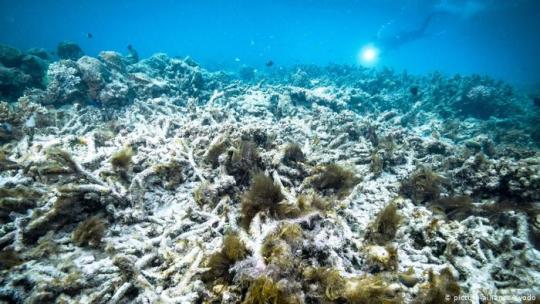
The Great Barrier Reef has lost around half its corals since the 1990s
‘Our extremes are more extreme’
Among those sites with a more positive outlook are the Comoe National Park in Ivory Coast which Shadie identifies as an “inspiring example.” After concentrated conservation efforts to counter the effects of climate change in the park, populations of chimpanzees, elephants and buffaloes are stable and rare bird populations are on the rise.
For Fraser Island, the opposite may be true. Though the report was published before the current fire started burning, the authors noted that an increase in fires posed the greatest threat to the sandy island.
“Changes in the plant communities (on Fraser Island) may be driven by future climate change and accelerated by the increase in fires,” the IUCN report says. “It is felt that modern regimes driven by climate change will result in a decrease in native biodiversity with a possible increase in pyrogenic invasive plant species.”
“Our extremes are more extreme — hotter and windier, and when it does rain, it rains more intensely,” Australia bushfires expert Richard Thornton explained.
“It is extremely difficult to attribute any one bushfire, flood or cyclone to climate change,” he added. “But climate change is changing our underlying weather conditions, and causing more severe weather,” he added.
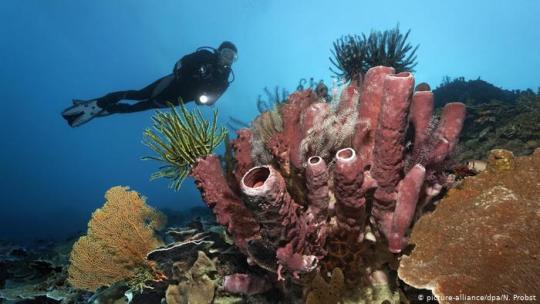
Doomsday tourism and climate change: Visiting natural wonders before they disappear
Transient treasure
Of the 2 million-odd people who visit the Great Barrier Reef annually, a 2016 survey found that 69 percent were coming to see the UNESCO World Heritage site “before it’s too late.” And no wonder. The IPCC says that even if we manage to limit global warming to 2 degrees Celsius, 99 percent of the world’s coral will be wiped out. Tourists can hasten their demise by touching or polluting reefs.
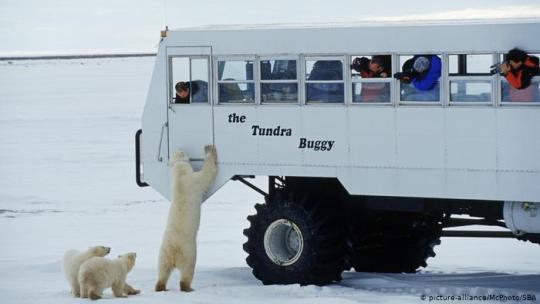
Doomsday tourism and climate change: Visiting natural wonders before they disappear
Bearly there
And what’s the carbon cost of flying to remote natural wonders under threat? A 2010 study found that the business of polar-bear safaris in Churchill, Canada, had an annual CO2 footprint of 20 megatons. Most visitors arrived by plane, and while 88 percent of them said humans were responsible for climate change, only 69 percent agreed that air travel was a contributing cause.
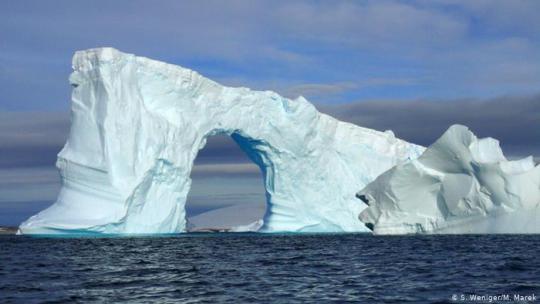
Doomsday tourism and climate change: Visiting natural wonders before they disappear
Art of the apocalypse
Along with the polar bear, one of the most iconic images of climate change must be the dramatic curves of an iceberg sculpted by the warming atmosphere. Gliding between the melting giants on a cruise ship is a haunting experience that tourists will pay huge sums for. In the early 1990s just 5,000 people visited Antarctica each year, compared to over 46,000 in 2018.
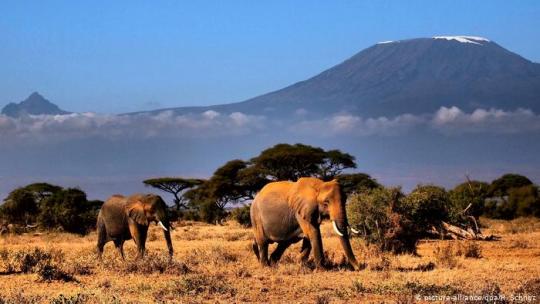
Doomsday tourism and climate change: Visiting natural wonders before they disappear
Peak season
You don’t have to go to the poles to see vanishing ice. Kilimanjaro’s snowy peaks are a striking sight above the equatorial savannah of the national park, which generates €44 million ($50 million) from tourism annually. Many visitors climb to the Furtwängler Glacier — where 85 percent of the ice has vanished over the last century. The rest is unlikely to survive much beyond mid-century.

Doomsday tourism and climate change: Visiting natural wonders before they disappear
King without a crown
When Montana’s Glacier National Park opened in 1910, it boasted over 100 of the ice features from which it took its name. Now, there are fewer than two dozen. So dramatic is their retreat, that the park has become a center of climate science research. Some 3 million hikers and holidaymakers also visit the “crown of the continent” each year, soaking in the dying days of its ice-capped glory.
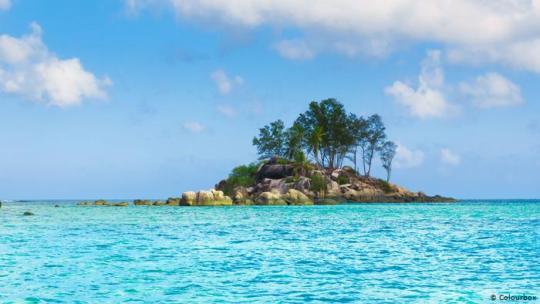
Doomsday tourism and climate change: Visiting natural wonders before they disappear
Paradise lost
The Maldives are the archetypal tourist paradise: 1,200 coral islands with white beaches rising just 2.5 meters above the turquoise waters. In 2017, the president decided to build new airports and megaresorts to accommodate seven times as many tourists, and use the revenue to build new islands and relocate communities. He has since been voted out of office and faces corruption charges.
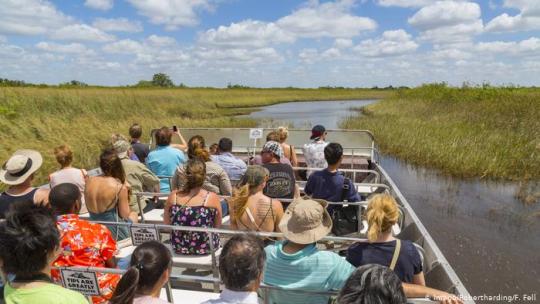
Doomsday tourism and climate change: Visiting natural wonders before they disappear
Saltwater swamps
It’s not just islands that are going under as sea levels rise. Wetlands like Florida’s Everglades are disappearing too. Over the last century, around half the Everglades have been drained and turned over to agriculture. Now, saltwater is seeping into what’s left, making it the only critically endangered World Heritage site in the United States.

Doomsday tourism and climate change: Visiting natural wonders before they disappear
Disturbing the peace
The Galapagos will be forever associated with Darwin, who realized their unique wildlife had evolved over countless generations in isolation. Today, they are besieged by visitors and environmental changes are happening too fast for species to adapt. Ocean warming has left iconic creatures like the marine iguana starving, while UNESCO lists tourism among the greatest threats to the archipelago.
Author: Ruby Russell
document.addEventListener("DOMContentLoaded", function (event) if (DWDE.dsgvo.isStoringCookiesOkay()) facebookTracking(); ); function facebookTracking() !function (f, b, e, v, n, t, s) if (f.fbq) return; n = f.fbq = function () n.callMethod ? n.callMethod.apply(n, arguments) : n.queue.push(arguments) ; if (!f._fbq) f._fbq = n; n.push = n; n.loaded = !0; n.version = '2.0'; n.queue = []; t = b.createElement(e); t.async = !0; t.src = v; s = b.getElementsByTagName(e)[0]; s.parentNode.insertBefore(t, s) (window, document, 'script', 'https://connect.facebook.net/en_US/fbevents.js'); fbq('init', '157204581336210'); fbq('track', 'ViewContent'); Source
0 notes
Text
How indigenous peoples resist COVID-19 in South America
New Post has been published on http://khalilhumam.com/how-indigenous-peoples-resist-covid-19-in-south-america/
How indigenous peoples resist COVID-19 in South America
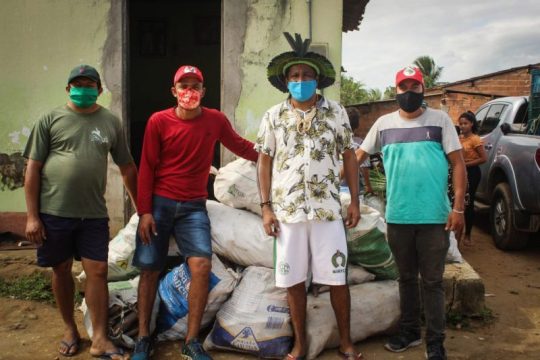
From Brazil to Bolivia, native peoples collectively care for their health
Farmers from the Brazilian Reforma Agraria Popular distributed about six tons of food to indigenous peoples during the pandemic. Photo credit: Vinícius Braga/Fotos Publicas (CC BY 3.0)
In Latin America, indigenous people are at higher risk of COVID-19 infection due to lack of data and historical political neglect, according to indigenous communities and human rights organizations. Malnutrition, anemia, and obesity rates are high and resources to build nearby hospitals are low. In Bolivia, for example, the Bolivian Center for Legal Studies and Social Research (CEJIS for its initials in Spanish) also warned about the risk of the “ethnocide” of indigneous groups in the context of COVID-19. Similar concerns have spread throughout the continent. To face the lack of access to basic sanitary services and absent public authorities, indigenous peoples are finding ways to cope with COVID-19. Here are ways the peoples of Yek'uana, Kayapo Mekranoti, São Gabriel da Cachoeira, San Antonio de Lomerío, Multi-Ethnic Indigenous Territory and Tsimané community in Venezuela, Brazil, and Bolivia are resisting the pandemic.
This map outlines all indigenous territories in the South American Amazon and highlights communities featured in this story. The shapes were created by Global Voices based on a database compiled by Amazonia Socioambiental, filtered using QGIS and edited on Photoshop and Illustrator.
Indigenous peoples in Venezuela protest for their rights through YouTube and Twitter
In Venezuela, information has gotten even rarer after indigenous leader and journalist Melquíades Avilás was arrested on March 13 in the state of Delta Amacuro mining area. He was detained after asking, “Will our hospital be ready for coronavirus?” on his Facebook account. The post was later deleted, as medics and other activists in the area denounced state negligence during the pandemic more anonymously. While the exact number of indigenous people who have contracted and died of COVID-19 in Venezuela is not clear, the UN estimates that nearly 5,000 indigenous Venezuelans have fled to Brazil due to the pandemic. In late June, three indigenous leaders from Yek'uana people in the southeastern Bolívar state read their official statement resuming how the pandemic and the quarantine measures have affected the lifestyle and reported 302 indigenous stuck outside of their communities. At the time of publication, they have not been able to come home because of the quarantine and lack of gasoline. The letter is read in the video below:[youtube https://www.youtube.com/watch?v=GKfD5U6500M] To find less individual ways to protests their situation, indigenous peoples and human rights activists also supported a virtual protest throughout July #HoyMeUnoAKapeKape (#TodayIJoinKapeKape) organized by the NGO Kapé Kapé and aimed at indigenous communities in Amazonas state to denounce the lack of food, cash, water, gasoline, public health system, access to medicine, and the violation of their democratic rights. They most frequently complained about the electoral authorities’ decision to eliminate the indigenous peoples’ direct voting methodology.
Felicito a @ackapekape por un nuevo aniversario. Y me uno a la campaña de respecto al derecho de la salud integral que tienen los pueblos indígenas, debido a falta de políticas públicas adecuadas, situación que se agrava por el #Covid_19 en la región #HoyMeUnoAKapeKape pic.twitter.com/GOIatwrJhf — Olnar Ortiz Bare (@olnarortiz) July 29, 2020
I congratulate @ackapekape on their new anniversary. And I join the campaign to respect the right to integral health of indigenous peoples, due to the lack of adequate public policies, a situation that is aggravated by #Covid_19 in the region #TodayIJoinKapeKape
In Brazil, indigenous communities show resistance by blocking a highway and building mobile hospitals
The pandemic reached Brazilian indigenous communities in the midst of a battle to maintain basic rights. On August 18, dozens of Amazonian indigenous leaders denounced the social inequalities in their region by blocking a strategic road for transporting grains to the state of Mato Grosso. Armed with bows and arrows, the Kayapo Mekranoti settled on the BR-163 highway near the city of Novo Progresso, in northern Brazil, about 80km from the village where the Kayapo people live, for ten days. The Kayapo sent a letter during the blockage to the Fundação Nacional do Índio (Funai), the government agency responsible for implementing policies concerning indigenous peoples in Brazil. In it, they claimed that they were being forced out from their lands and had little to no access to basic preventive measures against COVID-19. This community lives on Badjônkôre territory, an officially demarcated indigenous land since 2003 that is extremely valuable to gold miners, cattle owners, and wood companies. There is a national tendency, illustrated by the fires in the Amazon and Pantanal forests, to strategically exploit these areas which are legally attributed to indigenous communities. Since President Jair Bolsonaro took office, there has been a tug of war to remove protective measures on demarcated lands alongside guarantees of access to healthcare and basic sanitary conditions from indigenous communities. On September 15, the Kayapó people won their first legal victory on that matter; the Brazilian State now has to comply with indigenous environmental protection demands in this region.
No más deforestacion del Amazonas ! No más abandono ante #COVID19 ! Pueblo indígena Kapayo de #Brasil en resistencia. #vidasindigenasimportam pic.twitter.com/xXs9tqQQtW — 𝙼𝚊𝚛í𝚊 𝙽𝚘𝚎𝚕𝚒𝚊 𝙰𝚛á𝚞𝚣

(@noelia_arauz) August 19, 2020
No more deforestation in the Amazon! No more abandonment in the face of #COVID19! Indigenous people of Kapayo from #Brazil in resistance #indigenouslivesmatter
Even though COVID-19 spread fast in Brazil, the Brazilian city with most indigenous populations managed to extinguish its COVID-19 related deaths in July. Located on the border with Colombia and Venezuela, São Gabriel da Cachoeira is known for having more than 90% of the population composed of indigenous people who belong to about 23 different ethnicities. When the pandemic started, they established a curfew and organized local information campaigns, which included the production of podcasts and the circulation of a sound car through the city streets carrying information in indigenous languages, in order to prevent the disease from spreading. This was done in May, almost two months after the arrival of COVID-19 in Brazil, with the help of indigenous leaders who collaborated with foreign institutions, such as Doctors without borders and a national fund that aggregates donations from banks, hospitals, and members of civil society. Together, they have donated R$ 800,000 (150,703 US Dollars) to build nine mobile health units and start a massive testing campaign.
Indigenous peoples in Bolivia share their wisdom with the world
A recipe book, a handmade syrup, and a health protocol are what indigenous peoples from the low plains in eastern Bolivia advise to face the pandemic.
“San Antonio del Pallar community, multiethnic indigenous territory of Bosque de Chimanes, Bolivian Amazon”. Page 6 of Remedios del Monte [Remedies of Nature]. Photo by Fátima Monasterio Mercado, used with permission.
The leaders of the Multi-Ethnic Indigenous Territory (TIM for their initials in Spanish), who own land through collective title according to Bolivian law, published Remedios del Monte. Remedios del Monte can be loosely translated to remedies of nature, the forest, or the bush. Paulina Noza, the president of TIM's women's council, explained why to local press:
Hicimos este recetario, preocupados por la pandemia que brotó este año. (…) Por eso nosotros seguimos conservando [esos saberes] y ahora queremos que la gente lo conozca
We made the recipe book because we are worried about the pandemic. (…) We want people to know the age-old wisdom we preserve.
The lawyer and researcher Fátima Monasterio told local press that the use of natural medicine is a survival strategy due to the absence of the state. In fact, the recipe book’s presentation says:
En esta lucha por la vida, que se remonta a la memoria de los antiguos, seguiremos exigiendo el cumplimiento de nuestros derechos.
In this struggle for life, which dates back to our ancestor's memory, we will continue to demand the fulfillment of our rights.
The recipe book contains instructions to increase the body's natural defenses, cure colds, treat symptoms such as fever, diarrhea, and cough, and also shares recommendations to improve human's spiritual relationship with nature. Also, the Tsimané community, which belongs to TIM, developed a health protocol together with doctors and anthropologists that consists of special care for the elderly, controlling entry points into their territory, caring for quarantined people, contact tracing, and dissemination of information in their indigenous language. In the video below, TIM President Paula Noza explains the community's help and how entry points work. [youtube https://www.youtube.com/watch?v=QqAcoLwi2MI?feature=oembed&w=650&h=366] Meanwhile, José Parapaino Chuvirú, from the indigenous territory San Antonio de Lomerío, launched the traditional syrup “Sabor Original Kutuki” [“Kutuki Original Flavor”], made of the medicinal herb kutuki and macerated with a mixture of roots and leaves. According to testimonies mentioned in the platform Salud con Lupa, the beverage has been effective in calming COVID-19 symptoms.
https://connect.facebook.net/nl_NL/sdk.js#xfbml=1&version=v8.0
#NO_ESPERES_MÁS..


y#QuedateEnCasa..

.. Geplaatst door Chochio op Zondag 14 juni 2020
< p class='gv-rss-footer'>Written by Gabriela Mesones Rojo, Giovana Fleck, Fabiola Gutierrez
0 notes
Text
More than 11,000 scientists from around the world declare a ‘climate emergency’
Study outlines six major steps that ‘must’ be taken to address the situation.
A climate change protester holds a banner during a town hall event with former vice president Joe Biden in Manchester, N.H., on Oct. 9, 2019. (Kate Flock/Bloomberg News)
A climate change protester holds a banner during a town hall event with former vice president Joe Biden in Manchester, N.H., on Oct. 9, 2019. (Kate Flock/Bloomberg News)
By
Andrew Freedman
November 5, 2019 at 7:18 a.m. PST
A new report by 11,258 scientists in 153 countries from a broad range of disciplines warns that the planet “clearly and unequivocally faces a climate emergency,” and provides six broad policy goals that must be met to address it.
The analysis is a stark departure from recent scientific assessments of global warming, such as those of the U.N. Intergovernmental Panel on Climate Change, in that it does not couch its conclusions in the language of uncertainties, and it does prescribe policies.
The study, called the “World scientists’ warning of a climate emergency,” marks the first time a large group of scientists has formally come out in favor of labeling climate change an “emergency,” which the study notes is caused by many human trends that are together increasing greenhouse gas emissions.
AD
Keep Reading
The report, published Tuesday in the journal Bioscience, was spearheaded by the ecologists Bill Ripple and Christopher Wolf of Oregon State University, along with William Moomaw, a Tufts University climate scientist, and researchers in Australia and South Africa.
The study clearly lays out the huge challenge of reducing emissions of greenhouse gases.
“Despite 40 years of global climate negotiations, with few exceptions, we have generally conducted business as usual and have largely failed to address this predicament,” the study states.
The paper bases its conclusions on a set of easy-to-understand indicators that show the human influence on climate, such as 40 years of greenhouse gas emissions, economic trends, population growth rates, per capita meat production, and global tree cover loss, as well as consequences, such as global temperature trends and ocean heat content.
AD
Activist Greta Thunberg on how to make sure the world does not 'give up' the climate fight
After taking a solar-powered boat from England to New York to attend the United Nations Climate Action Summit, Thunberg discussed what activists need to do. (Jhaan Elker/The Washington Post)
The results are charts that are, at least compared with the climate graphics presented by the IPCC, surprisingly simple, and that help reveal the troubling direction the world is headed.
The study also departs from other major climate assessments in that it directly addresses the politically sensitive subject of population growth. The study notes that the global decline in fertility rates has “substantially slowed” during the past 20 years, and calls for “bold and drastic” changes in economic growth and population policies to cut greenhouse gas emissions. Such measures would include policies that strengthen human rights, especially for women and girls, and make family-planning services “available to all people,” the paper says.
On energy, the report calls for the world to “implement massive energy efficiency and conservation practices” and cut out fossil fuels in favor of renewable sources of energy, a trend it notes is not happening fast enough. It also calls for remaining fossil fuels, such as coal and oil, to remain in the ground, never to be burned to generate energy, a key goal for many climate activists.
A handout aerial photo made available by the Mato Grosso state government shows an area of forest burning in the Pantanal, Brazil, Oct. 31, 2019. (Chico Ribeiro/EPA-EFE/Shutterstock)
A handout aerial photo made available by the Mato Grosso state government shows an area of forest burning in the Pantanal, Brazil, Oct. 31, 2019. (Chico Ribeiro/EPA-EFE/Shutterstock)
Maria Abate, a signatory of the scientists’ warning and a biology professor at Simmons College in Boston, says she hopes the paper will raise awareness. “Like other organisms we are not adapted to recognize far-reaching environmental threats beyond our immediate surroundings,” she said via email. “The reported vital signs of our global activity and climate responses give us a tangible, evidence-based report card that I hope will help our culture to develop a broader awareness more quickly to slow this climate crisis.”
AD
ADVERTISING
Other items on the study’s list of policy priorities include quickly cutting emissions of short-lived climate pollutants, such as soot and methane, which could slow short-term warming. The study also calls for a shift to eating mostly plant-based foods and instituting agricultural practices that increase the amount of carbon the soil absorbs. On the economy, the study states that improving long-term sustainability and reducing inequality should be prioritized over growing wealth, as measured using gross domestic product. The authors also advocate for policies that would curtail biodiversity loss and the destruction of forests, and they recommend prioritizing the preservation of intact forests that store carbon along with other lands that can rapidly bury carbon, thereby reducing global warming.
“This is a document that establishes a clear record of the broad consensus among most scientists active at this point in history that the climate crisis is real, and is a major, even existential, threat to human societies, human well-being, and biodiversity,” said Jesse Bellemare, an associate professor of biology at Smith College who is a signatory of the study’s emergency declaration.
He said via email that the presence of so many biologists and ecologists on the list of signatories may reflect the fact that they are observing so many changes from an amount of climate change much smaller than what is projected for the future.
AD
Ripple, of Oregon State, is no stranger to organizing scientific calls to action, having founded the Alliance of World Scientists and organized scientists’ “Warning to Humanity: A Second Notice” in 2017, which was also published in Bioscience and focused on the urgent need to solve a broad array of environmental problems including climate change and biodiversity loss.
Thousands of scientists issue bleak ‘second notice’ to humanity
“We’re asking for a transformative change for humanity,” Ripple said in an interview. Many of the signatories to the warning do not list themselves as climate scientists but, instead, as biologists, ecologists and other science specialists. Ripple says that is intentional, as the authors sought to assemble the broadest support possible.
“The situation we’re in today with climate change,” he says, “shows that this is an issue that needs to move beyond climate scientists only.”
AD
Moomaw says the paper comes from researchers who are seeing the consequences of a rapidly changing planet, and is in part “a statement of frustration on the part of many in the scientific community.”
“Scientists, and in particular those that are studying what is happening in a changed climate, have become the most alarmed at how rapidly these changes are taking place and the urgency of needing to take far more drastic action,” Moomaw said.
The term “climate emergency” has been championed by climate activists and pro-climate action politicians seeking to add a sense of urgency to the way we respond to what is a long-term problem. The Climate Mobilization, an advocacy group, is seeking to have governments in the United States and elsewhere declare a climate emergency and enact response measures commensurate with such a declaration.
AD
New York’s City Council has declared a climate emergency, as has San Francisco. European cities have also taken this step. Bills labeling global warming as an emergency are pending in both the House and the Senate, endorsed by prominent liberals including Sen. Bernie Sanders (I-Vt.) and Rep. Alexandria Ocasio-Cortez (D-N.Y.).
The youth climate movement, including Swedish activist Greta Thunberg, has been leading the charge to ratchet up the language used in describing global warming.
To date, scientists have been reluctant to use such language. However, this study may change that.
Phil Duffy, a climate researcher and president of the Woods Hole Research Center, who added his name to the paper Monday, said he finds the term fitting, considering the scale of the problem and lack of action so far.
“The term ‘climate emergency’ … I must say, I find it refreshing, really, because you know, I get so impatient with the scientists who just are always just waffling and mumbling about uncertainty, blah, blah, blah, and this certainly is, you know, is much bolder than that,” he said. “I think it’s right to do that.”
0 notes
Text
Wildfire experts provide guidance for new research directions
https://sciencespies.com/nature/wildfire-experts-provide-guidance-for-new-research-directions/
Wildfire experts provide guidance for new research directions
As wildfires cause increasing devastation worldwide, dozens of fire experts across the nation are joining together in calling for a more strategic and interdisciplinary approach to pursuing wildfire research and protecting vulnerable communities.
A new study, led by a scientist at the National Center for Atmospheric Research (NCAR) and co-authored by 86 other fire experts from a breadth of disciplines, highlights the obstacles for fire science and provides guidance for investing in future research. The commentary is a follow-up to a five-day innovation lab, sponsored by the U.S. National Science Foundation (NSF), that brought together diverse research communities in May 2021 to develop a roadmap for new research directions.
Published in the Proceedings of the National Academy of Sciences (PNAS) Nexus journal, the study outlines five key challenges to advance the study of fire. These range from promoting coordinated research to drawing on diverse sources of knowledge.
“We need to develop a proactive fire research agenda that helps create safe communities and ecosystems,” said NCAR scientist Jacquelyn Shuman, the lead author. “This requires a more cross-disciplinary approach and building diverse partnerships to make better use of the knowledge that exists.”
The scientists are making their recommendations at a time when wildfires pose an increasing global risk, spurred largely by climate change, generations of fire suppression, and more development in the wildland-urban interface. Recent decades have seen a substantial increase in the length of fire season as far north as the Arctic, as well as intense conflagrations from the Pantanal tropical wetland in South America to the peatlands of tropical Asia. In the western United States, warmer and drier conditions have spurred fires that have burned nearly twice the area in the 21st century compared with the late 20th century.
Despite the growing wildfire destruction, the authors emphasize fire is a fundamental part of ecosystems globally, and it has been used by society to manage landscapes for millennia.
The innovation lab motivating this commentary was funded by NSF, which is NCAR’s sponsor.
Major research advances
Using increasingly advanced observing systems, field campaigns and computer models, scientists have made major strides in better understanding and anticipating wildfire behavior, as well as the effects of smoke on air quality. However, such advances have often been made in isolation, instead of being incorporated into a comprehensive and holistic understanding of the causes and impacts of fires.
Recognizing the need for a more convergent approach, the innovation lab last year brought together experts at federal agencies and universities. They represented fields ranging from ecology, forestry and anthropology to geomorphology, hydrology, and computer science, among others.
The five challenges outlined in the paper, which built on those discussions, are:
Integrate across disciplines by promoting coordination among physical, biological, and social sciences. Fire research currently is siloed within disciplines such as forestry, atmospheric chemistry, and others, but wildfire is a biophysical and social phenomenon that cannot be understood with any single disciplinary lens.
Embrace different ways of knowing and knowledge generation to identify resilience pathways. Humans from diverse groups and perspectives, including indigenous peoples of tribal nations, can provide scientists with invaluable insights into fire.
Use fire as a lens to address fundamental science questions. Fire is such an ancient and pervasive phenomenon that it can be used to help gain new insights into a range of sciences, including ecology and evolutionary biology, the evolution of Homo sapiens, and social dynamics.
Capitalize on the “firehose” of data to support community values. With more data now available to study fire in the biosphere than ever before, scientists need funding to harness the data revolution and aid our understanding of fire.
Develop coupled models that include human dimensions to better anticipate future fire. To better anticipate future fire activity and its impacts, scientists need to develop more advanced computer modeling systems that incorporate both the human and non-human dimensions of fire.
“We have far more information about fires than before, but we need increased funding and better coordination to deploy it on a global scale,” Shuman said. “This will enable us to be more proactive as we work to help society and ecosystems become more resilient to the increasing risk of fires.”
#Nature
0 notes
Text
Bonito, Brazil
7/9/17
Okay so Bonito was, well exactly as the name implies, very beautiful. Unfortunately I only had time for a couple days here and will be headed out in the morning 💔 I didn't do enough research before coming and figured Bonito was part of the Pantanal or very close to it...it's not. It's about a 5 hour drive away, so tomorrow morning I'm head out on a three day (more like 2 though after the driving) tour of the Pantanal. Bonito is basically paradise but also crazy expensive, so it's probably best I don't stay longer anyway. Not that the Pantanal is any cheaper.
The first day I was here I went to the Balneario Municipal, which is basically just a park that a bunch of locals visit regularly for free, but that tourist are overcharged to enter. I say that like it wasn't a completely gorgeous place to hang out and soak up the sun. It's basically this natural river that flows super slowly through this park and you can swim in very clear water with a bunch of fish. I spent three hours here and even met a life guard who showed me some birds and an anaconda that was casually hanging out on an island in the center of the river..no big deal. He also showed me these waterfalls in a blocked off area and I went swimming there, which was an awesome experience...until he tried to kiss me. Again with the creepy Brazilian men! The best part was I barely even understood him because he didn't speak English or Spanish even though he could understand my Spanish 😂 wtf. Aside from that though it was a really nice place.

Today I started my morning with a tour to Gruta do Lago Azul, a cave where we saw a bunch of stalagmites and stalactites, but the coolest part was the insanely blue lake that lies within it. Apparently the water gets as far as 7-8 meters deep, but no one really knows how large or deep the lake is. There is a hole at one end where the water continues that is too small for anyone to pass.

Afterwards I headed to Rio da Prata, another crystal clear river where we went snorkeling and basically just float down the river and admired the colors and the fish. Can't say the variety of fish anywhere near compared to what we experienced in Belize last summer, there were probably only 4 main types that we saw a bunch of. However this experience was really different in that when you popped your head out of the water all you heard was the sounds of a million types of birds in the jungle. It was really cool and very relaxing!
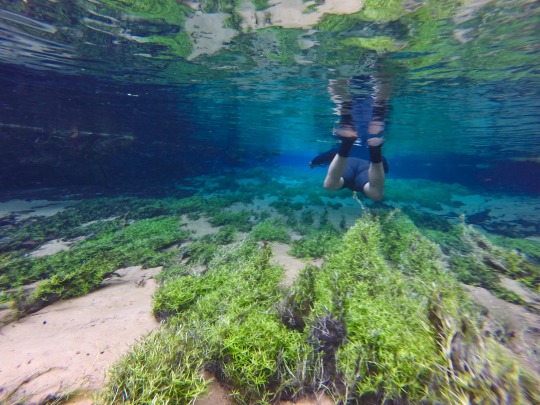
Here's a list of animals that I've seen thus far, either from the car or at one of these sites!
Ant eater Monkeys Anaconda Wild cows and horses Ostriches Parrots A million other types of birds I couldn't name And obviously some fish
1 note
·
View note